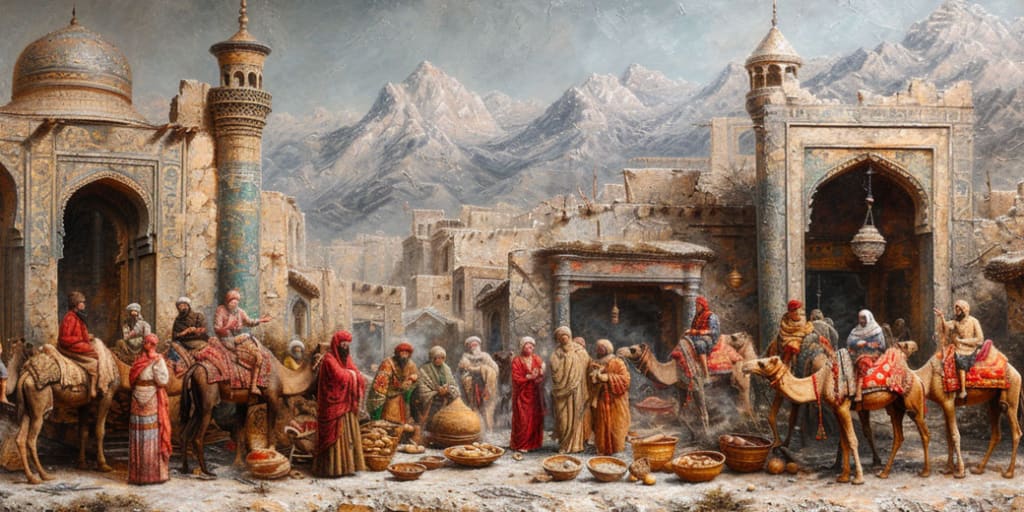The Silk Road: The Ancient Network That Shaped Civilizations
History

The Silk Road, an extensive network of trade routes, profoundly influenced the cultural, economic, and political landscapes of the ancient world. Spanning from China to the Mediterranean, this intricate web of pathways facilitated the exchange of goods, ideas, and innovations, leaving an indelible mark on the civilizations it connected. This article explores the origins, significance, and lasting legacy of the Silk Road.
The origins of the Silk Road can be traced back to the Han Dynasty of China, around the 2nd century BCE. Emperor Wu of Han is credited with establishing the initial routes to secure alliances and trade relations with distant lands. The primary motivation behind this endeavor was the lucrative silk trade. Chinese silk, renowned for its quality and beauty, was highly sought after in the West. As merchants and travelers journeyed across vast deserts, mountains, and plains, the Silk Road gradually expanded into a complex network of interconnected trade routes.
The term "Silk Road" is somewhat of a misnomer, as the network facilitated the exchange of far more than just silk. A diverse array of goods flowed along these routes, including spices, precious metals, gemstones, ceramics, glassware, textiles, and even exotic animals. In addition to tangible goods, the Silk Road was a conduit for the transmission of knowledge, culture, and religion. Philosophies, scientific advancements, and artistic techniques were shared among the various civilizations along the route, fostering a rich tapestry of cultural exchange.
One of the most significant impacts of the Silk Road was the spread of religion. Buddhism, in particular, found fertile ground along these trade routes. Originating in India, Buddhism spread to Central Asia, China, and beyond, largely due to the interactions facilitated by the Silk Road. Buddhist monasteries and stupas sprang up along the routes, serving not only as religious centers but also as hubs of learning and culture. Other religions, such as Islam, Zoroastrianism, and Nestorian Christianity, also traveled these pathways, contributing to the diverse religious landscape of the regions.
The Silk Road was not a single, continuous road but rather a series of interconnected routes. The primary overland routes traversed through regions like Central Asia, Persia, and the Arabian Peninsula, while maritime routes extended across the Indian Ocean. Key cities and trading posts emerged along these routes, including Samarkand, Bukhara, Kashgar, and Xi'an. These cities became melting pots of cultures, languages, and ideas, fostering a spirit of cosmopolitanism and innovation.
Trade along the Silk Road was not without its challenges. Merchants faced harsh climates, treacherous terrains, and the constant threat of banditry. Caravans of camels, often referred to as the "ships of the desert," were essential for traversing the arid expanses of the deserts. The Silk Road also necessitated diplomatic negotiations and alliances to ensure safe passage through various territories. Despite these obstacles, the rewards of successful trade made the journey worthwhile, leading to the prosperity of many regions along the route.
The Silk Road reached its zenith during the Tang Dynasty in China (618-907 CE) and the subsequent Mongol Empire (13th-14th centuries CE). The Pax Mongolica, or Mongol Peace, established by Genghis Khan and his successors, ensured a period of stability and security along the Silk Road, facilitating unprecedented levels of trade and cultural exchange. The Mongols themselves were instrumental in connecting the East and West, with their vast empire encompassing much of the Silk Road network.
However, the decline of the Mongol Empire and the rise of maritime trade routes in the late Middle Ages led to the gradual decline of the Silk Road. The advent of the Age of Exploration and the discovery of sea routes to Asia by European explorers shifted the focus of global trade to the oceans, diminishing the importance of overland routes. Despite its decline, the legacy of the Silk Road endures.
The Silk Road's impact on global history is immeasurable. It fostered economic interdependence, cultural diffusion, and technological innovation. The cross-cultural interactions along the Silk Road laid the groundwork for the interconnected world we live in today. Modern initiatives, such as China's Belt and Road Initiative, seek to revive the spirit of the Silk Road by promoting infrastructure development and economic cooperation across Asia and beyond.
In conclusion, the Silk Road stands as a testament to the power of trade and cultural exchange in shaping human history. It was a lifeline that connected distant civilizations, enabling the flow of goods, ideas, and innovations that enriched societies across continents. The enduring legacy of the Silk Road reminds us of the importance of connectivity and collaboration in our globalized world, and its history continues to inspire efforts to build bridges between cultures and nations.
About the Creator
Marveline Merab
“History never repeats itself. Man always does.”
― Voltaire
Enjoyed the story? Support the Creator.
Subscribe for free to receive all their stories in your feed. You could also pledge your support or give them a one-off tip, letting them know you appreciate their work.






Comments
There are no comments for this story
Be the first to respond and start the conversation.